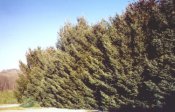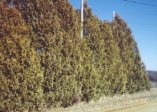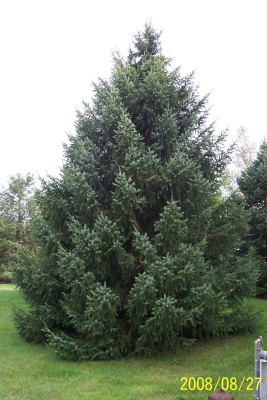Serbian Spruce - Picea Omorika
For prices and sizes click here.
Serbian Spruce growing in Iowa.
The Serbian Spruce is a medium to fast growing (2ft + per year) evergreen that has a needle that is 1 inch long and is dark green on the top and a silver on the bottom. It never drops its needles and holds them for up to 10 years. Its small purple seed cones are quite interesting. It is a native of a small area of Serbia and Yugoslavia where it grows on limestone hillsides along the Drina river. Unfortunately they are expected to be extinct within 200 years in their native area, due to many factors explained below.
It can grow to 50+ ft tall and 20+ft wide, and like other spruces it is wind firm and has a tough flexible wood. Heavy snow and ice storms cause little damage to this tree. Deer do not like to eat this tree unless nothing else is available.
This tree has become more acceptable to this area (Midwest) of the country and is more adaptable than originally thought. It has a hardiness rating from zone 4-7 has withstood -38F and strong winds with no winterburn or problems in Iowa. It is able to tolerate a high PH soil (9+) and still grow very well, so is well adapted for along gravel roads. I have planted it in areas of limestone rocks and they are growing fine.
The Serbian spruce does not like wet feet so needs an area that is well drained or on a slope where the excess water can drain away. Enjoys 25’ or more of rainfall per year, I avoid very sandy soils as with all spruce. Have not seen any fungal diseases or insect pests that effect this tree.
A 2ft Potted tree should be over 9 ft tall after 5 years with good soil, adequate moisture, and total weed and grass control, with no mulch. Spacing-- single row 14 ft apart, double row18 ft apart, multiple rows 20ft apart or more with the trees staggered from the other row.
The Serbian spruce in Iowa is doing very well and is a highly recommended windbreak tree from Iowa east to the Atlantic. It would do the best on the inside rows of windbreaks or on high PH soils where its striking color and growth can be appreciated along with the windbreak protection.
Serbian Spruce in Tara National Forest, Serbia.
Below are pictures of my trip to Serbia to see and study the Serbian Spruce
To learn about the Serbian Spruce from Serbian foresters Vladan Ivetić and Jelena Aleksić go here.
Explanation of the Serbian Spruce as described in the Tara National Forest, Serbia.
Serbian spruce grow in pure stands in Serbia as they are a pioneer species.
Seed cones on the Serbian Spruce
Picture of Botnist, Josif Pancie that discovered the Serbian Spruce in 1875.
My meeting with Vladan Ivetic, Forestry Professor at the University of Belgrade in Serbia to learn about the Serbian Spruce
Drina River in Tara National Forest, Serbia. Limestone bluffs with lots of limestone outcroppings are the home of the Serbian Spruce.
Kelly Tree Farm, 191 Quincy Ave. Clarence IA 52216 - PH: 563-452-4300 - ktf@netins.net










